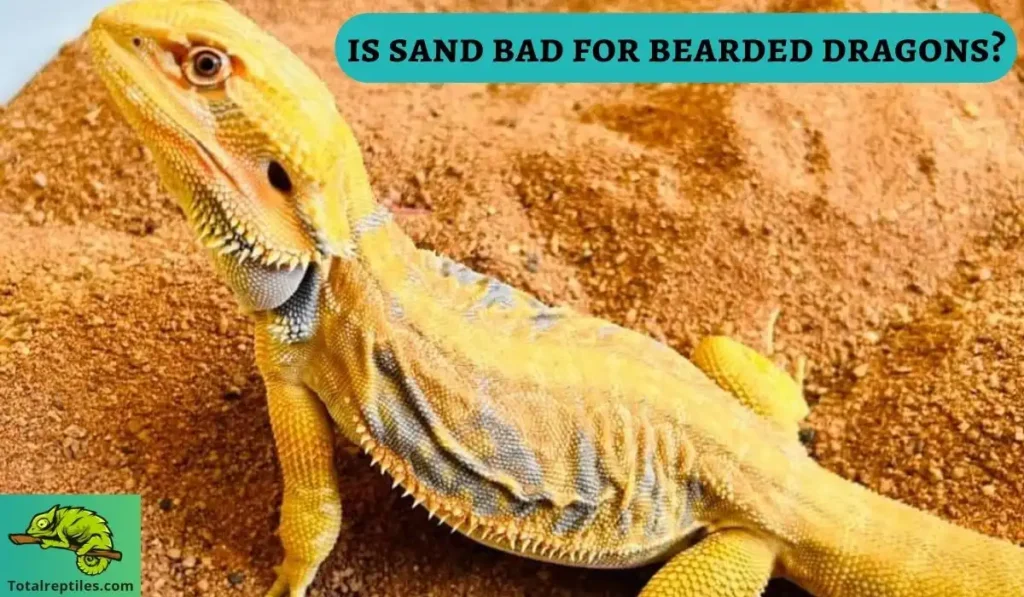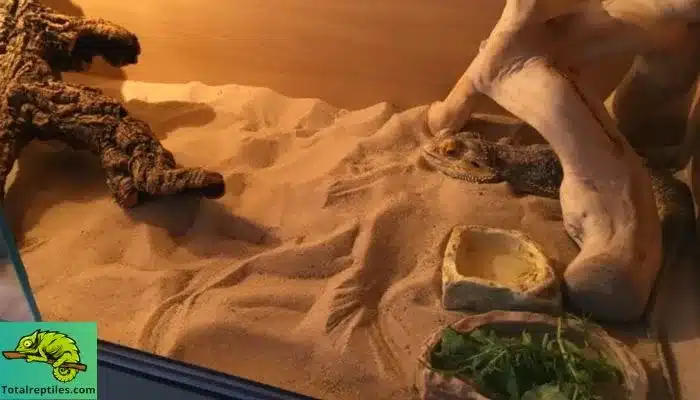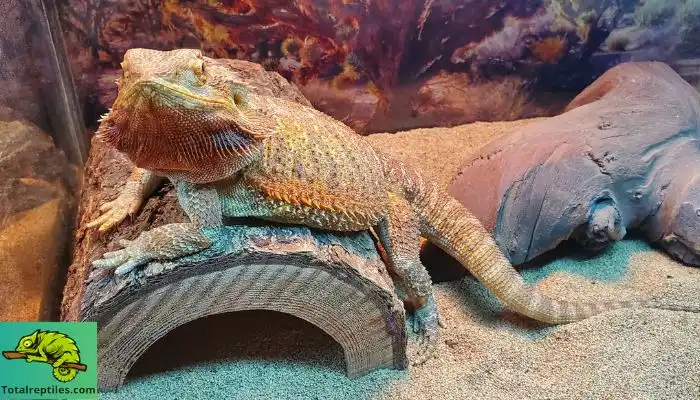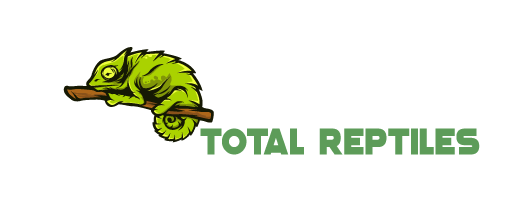Want to keep bearded dragons as pets? Well, there are a few things that you need to do right before getting them. For example, choosing the correct substrate for their enclosure. That brings out the question, is sand bad for bearded dragons?
Sand is bad for bearded dragons. As a substrate, it has uniform fine particles. These particles can get stuck into the eyes or ears of bearded dragons, which will cause irritation. They even accidentally ingest sand, causing different health issues to come up.
But could there be any reason why sand is not bad for your bearded dragon? If you want to learn more about the topic, you need to read through all the info that this discussion offers.

Is Sand Good for Bearded Dragons?
Sand is available in the natural habitat of bearded dragons. Although sand is a natural substrate, it is not necessarily a good choice for their habitat. But the real question is, why is sand bad for bearded dragons? Let’s take a closer look:
Impaction
Before getting into the details, let’s first learn what impaction is. So, in bearded dragons, impaction is a condition where they ingest an object that eventually leads to digestive issues and pain. In fact, impaction can potentially lead to death.
Now, bearded dragons are known for ingesting sand while exploring the environment. They can even eat sand to correct mineral deficiency found in their body. But that can be avoided by supplementing them with calcium.
Even so, you can not prevent them from ingesting sand when digging the substrate. For that reason, even if you have the safest wood in their enclosure, having sand in their habitat is undoubtedly a thing to worry about.
Hygiene Concerns
As mentioned earlier, bearded dragons tread through sand in their natural habitat. So, putting sand straight from the outside in their enclosure makes sense, right? Wrong! Sand can harbor tons of different bacteria and parasites!
Let’s not forget to mention that sand is one of the most challenging natural elements to clean. Therefore, when you introduce sand into the enclosure, you are putting the bearded dragons’ health at risk.

Shedding Difficulties
Bearded dragons are known for shedding frequently. However, sand can deteriorate the natural process. As a substrate, sand can stick to their skin, making it hard for them to shed.
When Can I Put Sand in Bearded Dragon Tank?
You may still use sand as a substrate, even with the bad sides. After all, it is a natural substrate for bearded dragons. In such cases, you must take proper precautions.
For example, make sure that the sand has larger grains than usual, lowering the chance of it being stuck in the eyes and ears of the bearded dragons. Secondly, you can choose to mix it with other substrates.
If you use sand, you should also monitor the enclosure regularly. Ensure that the sand is not damp. Dam sand will spread more bacteria and parasites.
Also, keep a close eye on whether they are eating the sand. Eating sand will lead to impaction, making them face different health issues.
In short, when you take proper precautions regarding the side effects, you can put sand in the bearded dragon’s tank. So, the answer to the can you put sand in a bearded dragon tank is generally a no.
Is Calcium Sand Good for Bearded Dragons?
Sand, in general, is not suitable for bearded dragons for all the reasons discussed earlier. And it does not really matter what type of sand it is. You should avoid putting it into the enclosure. That includes calcium sand too.
One of the significant risks of calcium sand is that it has uniformly fine particles, just like regular sand. As a result, it can get stuck to the skin of bearded dragons, causing irritations. Also, calcium sand can harbor many bacterias and parasites.

Is Play Sand Safe for Bearded Dragons?
Even children’s play sand is not safe for bearded dragons. You can argue that play sand is generally cleaner than regular sand. But that only lowers the risk of facing health issues for bacteria and parasites.
Play sand can still make bearded dragons feel skin irritation, making them less likely to shed at a regular frequency. Moreover, these reptiles can eat the play sand when they are digging and exploring, which, as you know, will lead to impaction.
Alternatives to Sand as a Substrate for Bearded Dragons
Typically, if you are looking for the best substrate for bearded dragons, you would want to avoid loose ones. And keeping that in consideration, you can choose one of these:
- Reptile carpet
At the core, reptile carpets are made from recycled plastic and look just like grass. You will find this substrate being on sale as a starter kit for keeping bearded dragons as pets. And the great part is that it comes in different sizes and colors.
On the note of sizes, you can cut the carpet according to your need. That makes reptile carpets best for every enclosure. However, you should note that the substrate is not easy to clean. You must put in a little extra effort and work into that.
You should thoroughly wash the reptile carpets at least twice every month. That will lower the chances of bacteria growing in the substrate.
- Paper Towels or Newspapers
Do you not want to spend too much on bearded dragon enclosure substrate? You don’t have to make any additional purchases at all! You have paper towels or newspapers at your home, right? Well, you can use them as a substrate!
This is generally best for juvenile or baby bearded dragons. Want to know why? Younglings tend to defecate a lot, which makes it hard to keep the substrate clean. But paper towels or newspapers are easy to replace!
You can even use paper towels or newspapers for old bearded dragons. But know that the substrate will not win any beauty pageants. So, if you want a natural-looking enclosure, opt for something else.
- Ceramic Tiles
Even though ceramic tiles might not be popular, they are a great pick as a bearded dragon enclosure substrate. To start with, ceramic tiles will offer you the most “natural” looking setup.
Secondly, these tiles are natural heat conductions that do not absorb moisture. That means you will not need to worry too much about the cleaning process. Finally, they do not warp, making the basking spot remain pristine.
However, there’s one significant disadvantage. You can not easily shape and cut the ceramic tiles. Instead, you need to work with specific tools, which can be an added cost.
- Rubber Shelf Liner
You probably have rubber shelf liners right at your home. Wondering where could they be? Check your drawers and shelves in the kitchen. Yes, the thin pieces of rubber line the drawers or shelves are shelf liners.
Nonetheless, the great part is that rubber shelf liners are great for all types of enclosures. And they are suitable for bearded dragons of all ages. Most importantly, they can be bought for an affordable price. You can get them for around $10 per roll!
However, rubber shelf liners have issues with heat. The enclosure’s tank heater or basking bulb will make them shrink or crack. So, you might occasionally find yourself correcting the tank’s temperature with this substrate.
Final Words
To recap, is sand bad for bearded dragons? In short, sand is not a good pick as a substrate for bearded dragons. Many risks come with this natural substrate, making them not ideal for the enclosure.
Instead, opt for the alternatives mentioned in this discussion. In fact, if you don’t want to spend too much, just use newspapers or paper towels available in your home.

